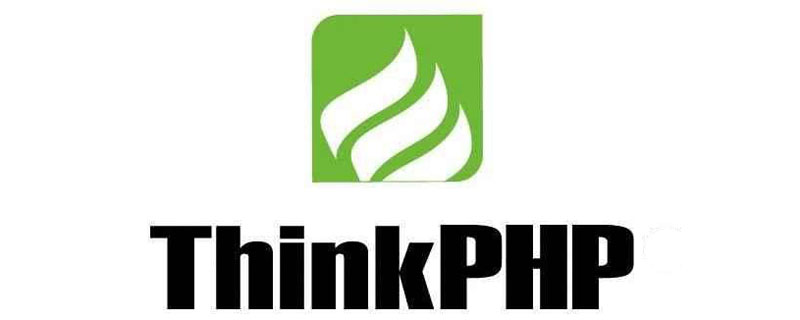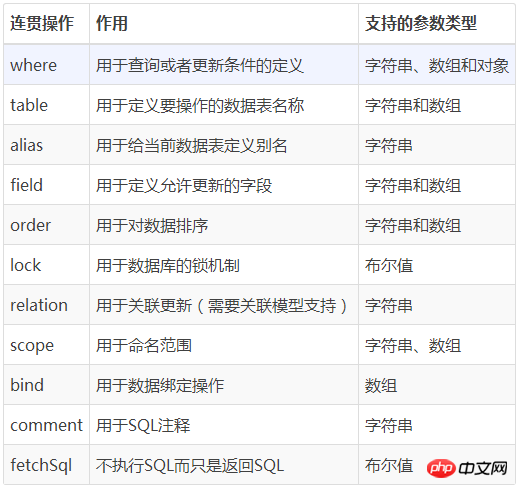How to update data in ThinkPHP? (detailed examples)
This article introduces you to a detailed example of how thinkphp implements updated data and five methods for thinkphp to update the database. This article introduces very well and has reference value. Interested friends can refer to it

Before introducing the main text, let me introduce to you the coherent operation methods supported by the data update method:

In the previous article In this article, we implemented data deletion and batch deletion. In this article, we will implement data update.
The first is still the expected rendering: 
Click to modify and enter the modi.html page, and then Make modifications, such as modifying the real name attribute here:

Click to save:

The above is the effect to be achieved. The following is the specific code to achieve:
The first is still the code in the view:
<form role="form" method="post" action="__MODULE__/Admin/User/doAdd"> <p class="input-group"> <span class="input-group-addon">用<img src="__PUBLIC__/end/images/em.png" alt="" width="6" height="20">户<img src="__PUBLIC__/end/images/em.png" alt="" width="6" height="20">名:</span> <input type="text" class="form-control" placeholder="" name="username"> </p> <p class="input-group "> <span class="input-group-addon" for="inputWarning1">真实姓名:</span> <input type="text" class="form-control" placeholder="" id="input" name="realname"> </p> <p class="input-group"> <span class="input-group-addon">手机号码:</span> <input type="text" class="form-control" placeholder="" name="telphone"> </p> <p class="input-group"> <span class="input-group-addon">电子邮箱:</span> <input type="text" class="form-control" placeholder="" name="email"> </p> <p class="input-group"> <span class="input-group-addon">添加时间:</span> <input type="text" class="form-control" placeholder="2014-05-22" name="resgistertime"> </p> <p class="input-group"> <span class="input-group-addon">设置密码:</span> <input type="text" class="form-control" placeholder="123456" name="password"> </p> <p class="input-group"> <span class="input-group-addon">确认密码:</span> <input type="text" class="form-control" placeholder="123456" name="repassword"> </p> <p class="input-group"> <button type="submit" class="btn btn-primary "> 保<img src="__PUBLIC__/end/images/em.png" alt="" width="20" height="20">存 </button> </p> </form>
The next is the controller: What needs to be explained is that what is needed here The purpose of writing the unmodified value is mainly to facilitate the user's memo, so it is necessary to make an if branch judgment:
public function modi(){
if (IS_POST) {
$adminUsersModel = D("adminUsers");
$adminUsersModel->create();
// var_dump($adminUsersModel);
// exit("创建成功!");
if($adminUsersModel->save()){
$this->success("修改成功", U("Admin/User/lists"));
}
else {
$this->error($adminUsersModel->getError());
}
}
else {
$id = isset($_GET['id']) ? intval($_GET['id']) : '';
if ($id == '') {
exit("bad param! 请输入id");
}
$adminUsersModel=D("adminUsers");
$adminUsers=$adminUsersModel->find($id);
//var_dump($adminUsers);
$this->assign("adminUsers", $adminUsers);
$this->display();
}
}The following will introduce how thinkphp updates the database. Five methods
The first method:
$Model->where('id=1')->save( $data);
Second method:
$model->where('id=1')->data($data)-> ;save();
The third method:
$Model->create();
$Model-> ;save();
The form must contain a hidden field named with the primary key
Fourth method:
$ Model->where('id=5')->setField('name','ThinkPHP');
$Model->where('id=5')-> ;setField(array('name','email'),array('TP','TP@163.com'));
//The fourth method, when passing an array, I can't implement it . . .
Fifth method:
$Model->setInc('score','id=5',3); // Point addition 3
$Model->setInc('score','id=5'); // Points plus 1
$Model->setDec(' score','id=5',5); //Score minus 5
$model->setDec('score','id=5'); //Score minus 1
Related recommendations:
thinkphp implements 163, QQ mailbox method of sending and receiving emails_php skills
##ThinkPHP implements simple login function
The above is the detailed content of How to update data in ThinkPHP? (detailed examples). For more information, please follow other related articles on the PHP Chinese website!

Hot AI Tools

Undresser.AI Undress
AI-powered app for creating realistic nude photos

AI Clothes Remover
Online AI tool for removing clothes from photos.

Undress AI Tool
Undress images for free

Clothoff.io
AI clothes remover

Video Face Swap
Swap faces in any video effortlessly with our completely free AI face swap tool!

Hot Article

Hot Tools

Notepad++7.3.1
Easy-to-use and free code editor

SublimeText3 Chinese version
Chinese version, very easy to use

Zend Studio 13.0.1
Powerful PHP integrated development environment

Dreamweaver CS6
Visual web development tools

SublimeText3 Mac version
God-level code editing software (SublimeText3)

Hot Topics
 1664
1664
 14
14
 1423
1423
 52
52
 1317
1317
 25
25
 1268
1268
 29
29
 1246
1246
 24
24
 PHP and Python: Comparing Two Popular Programming Languages
Apr 14, 2025 am 12:13 AM
PHP and Python: Comparing Two Popular Programming Languages
Apr 14, 2025 am 12:13 AM
PHP and Python each have their own advantages, and choose according to project requirements. 1.PHP is suitable for web development, especially for rapid development and maintenance of websites. 2. Python is suitable for data science, machine learning and artificial intelligence, with concise syntax and suitable for beginners.
 PHP in Action: Real-World Examples and Applications
Apr 14, 2025 am 12:19 AM
PHP in Action: Real-World Examples and Applications
Apr 14, 2025 am 12:19 AM
PHP is widely used in e-commerce, content management systems and API development. 1) E-commerce: used for shopping cart function and payment processing. 2) Content management system: used for dynamic content generation and user management. 3) API development: used for RESTful API development and API security. Through performance optimization and best practices, the efficiency and maintainability of PHP applications are improved.
 Explain secure password hashing in PHP (e.g., password_hash, password_verify). Why not use MD5 or SHA1?
Apr 17, 2025 am 12:06 AM
Explain secure password hashing in PHP (e.g., password_hash, password_verify). Why not use MD5 or SHA1?
Apr 17, 2025 am 12:06 AM
In PHP, password_hash and password_verify functions should be used to implement secure password hashing, and MD5 or SHA1 should not be used. 1) password_hash generates a hash containing salt values to enhance security. 2) Password_verify verify password and ensure security by comparing hash values. 3) MD5 and SHA1 are vulnerable and lack salt values, and are not suitable for modern password security.
 How does PHP handle file uploads securely?
Apr 10, 2025 am 09:37 AM
How does PHP handle file uploads securely?
Apr 10, 2025 am 09:37 AM
PHP handles file uploads through the $\_FILES variable. The methods to ensure security include: 1. Check upload errors, 2. Verify file type and size, 3. Prevent file overwriting, 4. Move files to a permanent storage location.
 PHP: A Key Language for Web Development
Apr 13, 2025 am 12:08 AM
PHP: A Key Language for Web Development
Apr 13, 2025 am 12:08 AM
PHP is a scripting language widely used on the server side, especially suitable for web development. 1.PHP can embed HTML, process HTTP requests and responses, and supports a variety of databases. 2.PHP is used to generate dynamic web content, process form data, access databases, etc., with strong community support and open source resources. 3. PHP is an interpreted language, and the execution process includes lexical analysis, grammatical analysis, compilation and execution. 4.PHP can be combined with MySQL for advanced applications such as user registration systems. 5. When debugging PHP, you can use functions such as error_reporting() and var_dump(). 6. Optimize PHP code to use caching mechanisms, optimize database queries and use built-in functions. 7
 How does PHP type hinting work, including scalar types, return types, union types, and nullable types?
Apr 17, 2025 am 12:25 AM
How does PHP type hinting work, including scalar types, return types, union types, and nullable types?
Apr 17, 2025 am 12:25 AM
PHP type prompts to improve code quality and readability. 1) Scalar type tips: Since PHP7.0, basic data types are allowed to be specified in function parameters, such as int, float, etc. 2) Return type prompt: Ensure the consistency of the function return value type. 3) Union type prompt: Since PHP8.0, multiple types are allowed to be specified in function parameters or return values. 4) Nullable type prompt: Allows to include null values and handle functions that may return null values.
 The Enduring Relevance of PHP: Is It Still Alive?
Apr 14, 2025 am 12:12 AM
The Enduring Relevance of PHP: Is It Still Alive?
Apr 14, 2025 am 12:12 AM
PHP is still dynamic and still occupies an important position in the field of modern programming. 1) PHP's simplicity and powerful community support make it widely used in web development; 2) Its flexibility and stability make it outstanding in handling web forms, database operations and file processing; 3) PHP is constantly evolving and optimizing, suitable for beginners and experienced developers.
 PHP vs. Python: Understanding the Differences
Apr 11, 2025 am 12:15 AM
PHP vs. Python: Understanding the Differences
Apr 11, 2025 am 12:15 AM
PHP and Python each have their own advantages, and the choice should be based on project requirements. 1.PHP is suitable for web development, with simple syntax and high execution efficiency. 2. Python is suitable for data science and machine learning, with concise syntax and rich libraries.




